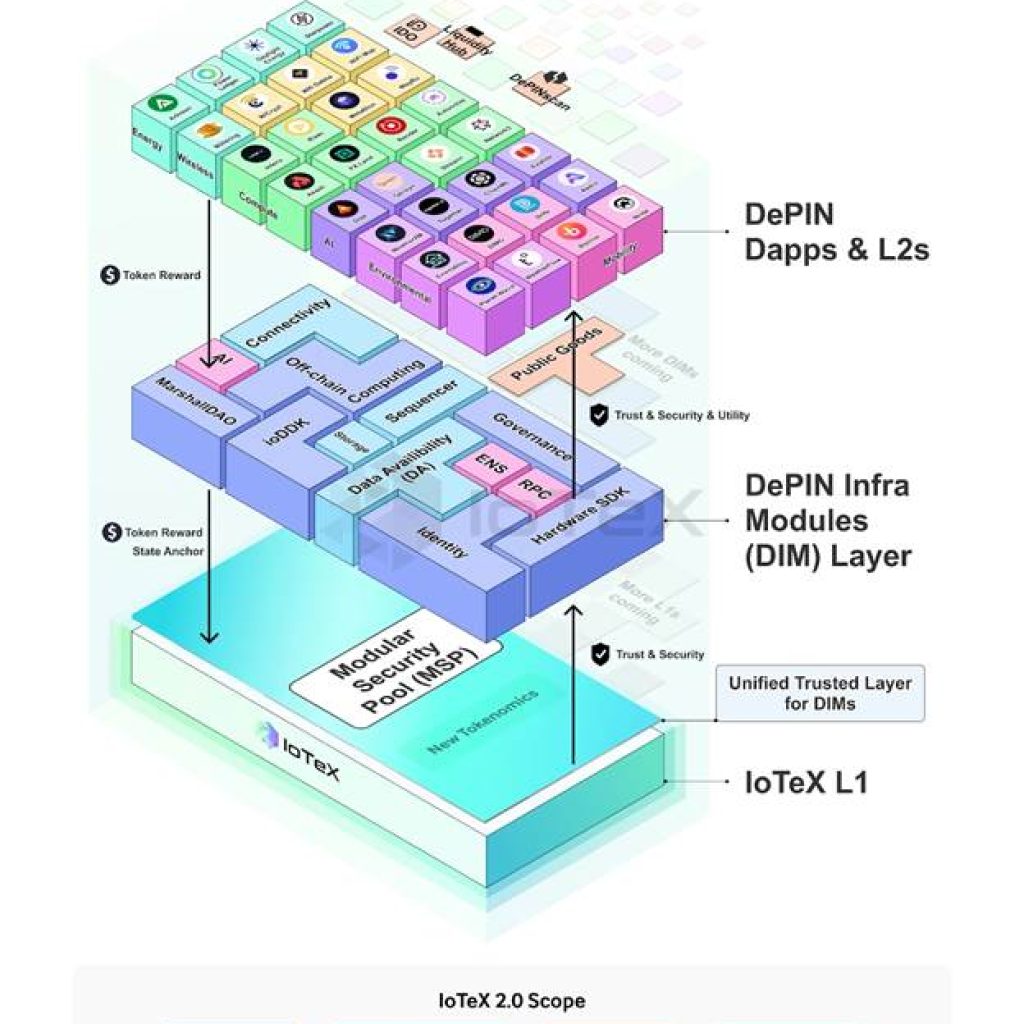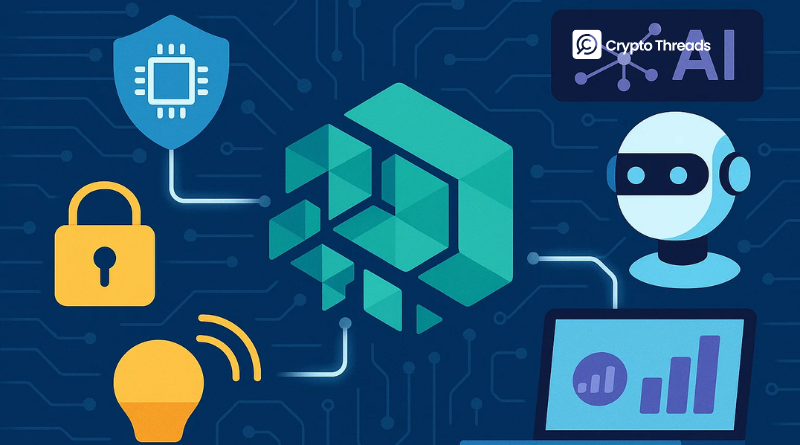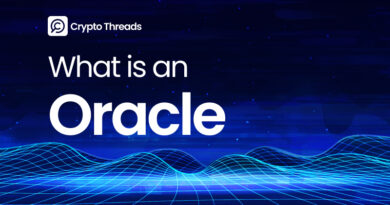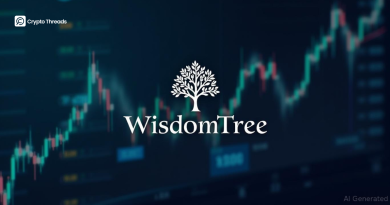Crypto Hidden Gem 01: IoTeX – DePIN and AI Integration for Everyone
We consider a hidden gem a project with strong fundamentals, a bold vision, and real-world use cases – but still flying under the mainstream radar. All of the project’s aspects are evaluated since we value long-term potential, breakthrough tech, and a clear roadmap, not just token pumps, though on-chain analysis is always assessed.
IoTeX is a Decentralized Physical Infrastructure Network built to revolutionize the world of crypto and Web2 ecosystem. With a unique architecture, a growing ecosystem of real-world applications, significant achievements, and a realistic & potential development roadmap, IoTeX is quietly building what could be the future of Web3 x IoT – making it a true hidden gem.
Key Takeaways
- IoTeX is building the infrastructure for a decentralized machine economy, connecting smart devices to blockchain to enable secure, autonomous machine-to-machine interactions.
- The IoTeX 2.0 upgrade turns the network into a modular platform tailored for DePIN and AI, making it dramatically easier to launch real-world applications like decentralized sensor networks and autonomous vehicles.
- QuickSilver bridges DePIN and AI, allowing developers to build AI agents that can interact with the physical world using real-time, verified data — a game-changer for intelligent, decentralized applications.
- W3bstream solves the core trust issue between blockchain and real-world data, enabling off-chain computation and proof generation that makes data from physical devices usable and reliable on-chain.
- IoTeX has quietly become one of the leading DePIN ecosystems, with over 60 DePIN protocols, a large developer base, and strategic integrations — yet it remains under the mainstream radar.
- Its token model and governance are designed for long-term sustainability, with a deflationary Burn-Drop mechanism, high staking participation (~40%), and a community-driven DAO managing reserves and growth.
What is IoTeX?
IoTeX is a decentralized platform designed specifically for the Internet of Things.
The project’s core vision is to empower people to own and control their smart devices and the data they generate by securely connecting the physical world to the blockchain – introducing the novel concept of “Internet of Trusted Things.” This could resolve critical issues of trust, security, and data sovereignty and therefore foster a decentralized machine economy where devices could interact and transact autonomously and securely.
1. IoTeX Overview
| Attribute | Value |
| Protocol Name | IoTeX |
| Website | https://iotex.io |
| Whitepaper | https://docs.iotex.io https://github.com/iotexproject/files/blob/main/publications/IoTeX_2_0_Whitepaper_1.1_EN.pdf |
| Founded in | 2017 |
| Founders | Raullen Chai, Qevan Guo, Jing Sun, Xinxin Fan |
| Ecosystem | 320+ projects |
| DePIN devices | 25M+ |
| Market Cap | $200.33M |
| Fully Diluted Value (FDV) | $212.19M |
| Circulating supply/Total supply | 9.44B IOTX/9.44B IOTX |
| Daily volume | $2 – $3M/day |
2. IoTeX History
In September 2017, IoTeX was founded with a vision to create a decentralized platform for the Internet of Things (IoT), which then evolved into the core concept of the “Internet of Trusted Things.”
From left to right, Dr. Raullen Chai (CEO), Dr. Qevan Guo, Jing Sun, and Dr. Xinxin Fan, respectively, are the founders of IoTeX.
Raullen Chain is a research scientist at the University of Waterloo and holds a PhD in cryptography. He started his career through a research fellowship at the University of Waterloo where he deeply studied lightweight cryptography, security and privacy in the Internet of Things (IoT), and privacy-preserving techniches for blokchain. After serving at Google as a Tech Lead from August 2013 to August 2016 and joining Uber as the Lead of Crypto R&D and Engineering Security, Dr. Chai left to found IoTeX along side Jing Sun and Dr. Qevan Guo.
These two friends of Raullen Chai share the same vibe with him as tech experts in security, blockchain, and IoT. Dr. Qeven Guo is a machine learning and computer vision PhD from the national University of Singapore. Before IoTeX, he worked as a research scientist and engineering manager at Facebook.
The third co-founder, Jing Sun, has led more than 40 investments in the field. She previously served as a founding partner at Sparkland Capital, a venture capital firm bridging Asia and Sillicon Valley. She has successfully established strategic partnerships for IoTeX, including collaborations with the Blockchain Foundation and Jinse, a blockchain-focused service platform. Additionally, a significant partnership was formed in June with CertiK, a leading firm specializing in smart contract security and verification, aimed at ensuring the robust security of IoTeX’s blockchain and its smart contracts.
The team welcomed Dr. Xinxin Fan as the last founding member after he left the Bosh Research and Technology Center in February 2018. Xinxin is now leading the Cryptography department at IoTeX.
IoTeX Core Features & Technology
IoTeX keeps its vision of a “decentralized machine economy” over years with two pioneering interconnected concepts:
- MachineFi: A blend of “machine” and “DeFi” – turning the data, resources, and services provided by IoT devices can be turned into digital assets that can be owned & traded by users.
- DePIN (Decentralized Physical Infrastructure Networks): Real-world networks built and maintained by a community of individuals and businesses. E.g., sensor networks, wireless hotspots, or energy grids.
However, with the rapid growth of Artificial Intelligence (AI), the founders’ vision for IoTeX is now all about DePIN and the tranformatvie potential of AI. You can now see the “IoTeX: DePIN + AI” line when searching for the project everywhere, marking a pivotal evolution of IoTeX – the shifting to IoTeX 2.0.
IoTeX 2.0 now focuses on providing Decentralized Infrastructure Modules for all DePIN projects.

IoTeX DIMs – Decentralized Infrastructure Modules
We’ve seen the high-level, strategic diagram of the architecture of IoTeX 2.0. To further explore the core technology of the new upgrade, here is a granular, technical diagram:
1. IoTeX Layer 1 Blockchain
Quick facts about the IoTeX blockchain:
| Technical Specification | Details |
| Block time | 5 seconds |
| TPS | 1,000 transactions/s |
| Transaction finality | Instant finality (all blocks are final; forks are not possible) |
| Validation & Consensus algorithms | Randomized Delegated Proof of Stake with PBFT (“Roll-DPoS”) |
| IOTX Staking | Token holders can stake on stake.iotex.io or directly inside the ioPay mobile wallet |
| Ethereum Chain IDs | 4689 (IoTeX Mainnet), 4690 (IoTeX Testnet) |
Randomized Delegated Proof of Stake (Roll-DPoS)
IoTeX combines 2 famous consensus mechanisms – Delegated Proof of Stake (DPoS) and Proctical Bizantine Fault Tolerance (PBFT) – and the Verifiable Random Functions (VRFs).
This is a huge upgrade in protecting the identity of a user, hiding transactions’ details, and ensuring that sensitive data be treated safely, minimizing the chance of being leaked or abused. One of the most important features of Roll-DPoS is its ability to achieve instant blokc finality, which means that once transactions are confirmed and pushed into a block, it’s done and cannot be reversed.
At a high level, IoTeX’s Roll-DPoS has four phases: elect candidates, form committee, propose block, and finalize block.
- Elect Candidates: All nodes staking at least 100 IOTX in the IoTeX network can participate in voting for their delegates. The candidates wil form a set of at least 36 individuals (will be increase in the future to further avoid the centralization of the mining power). Once we’ve selected the delegates, they will be fixed in one epoch consisting of 30 interations.
- Form the Committee: In each interation, a random committee of 24 is selected from the candidate pool using the VRF in the next 30 rounds. IoTeX use the VRF as in Algorand to ensure fairness and security in sorting all delegates for proposing blocks.
- Propose Block: For each round, each validator proposes a new block and broadcasts it to the network with its proof. The consensus allows only blocks proposed by the committee member and has not been propsed in the same iteration.
- Finalize Block: Now, all other nodes use PBFT to vote for/against the candidate block. If more than 2/3 of the committee agree on the validity of the block, it’s then finalized and is published to the network.
2. ioID – DePIN Identities
IoID is a decentralized identity framework designed to assign a unique and trustworthy digital identity to every participant in a DePIN network. You can think of it as a universal passport system for the machine economy, giving identities for people, devices, or physical AI.
However, ioID is not just a siple registration number. It’s a complicated system based on recognized global standards from the World Wide Web Consortium (W3C). Specifically, ioID includes on-chain and off-chain components:
- On-chain Identity: We match every machine with an NFT-bound smart contract wallet. This allows for managing digital assets, receiving rewards, and participating in Dapps and DeFi protocols.
- Device NFT: An on-chain token (ERC-721) that represents the ownership of the physical device. It’s the legal title or deed for the machine, recorded permanently on the blockchain.
- Machine-Bound Account (MBA): A smart contract wallt owned by the Device NFT.
- Off-chain Identity: To support communication between machines and humans (M2P) and machines and machines (M2M), ioID integrates Decentralized identifiers (DIDs) and verifiable credentials (VCs).
- DID is the digital passport for each entity
- VC is like a digital license issued by a trusted party that makes a specific claim about an identity.
The four foundational capabilities are:
| Feature | Description | Key Capabilities |
| Unified on-chain Registry for Machines | A “Google for Machines”: Universal registry of machines, smart agents, and physical AI with globally unique, metadata-rich identities | • Search and visualize machine identities • Verify ownership, geolocation, and operational status on-chain • Manage fleets or device networks at scale • depinscan.io platform for discovery, analytics, and onboarding |
| Machine-Bound Accounts (MBAs) | Programmable smart wallets linked to machine identity, interoperable across chains | • Receive and manage token rewards • Stake, lend, or rent tokens • Pay for services or engage in DeFi • Operate without human intermediaries |
| Autonomous Interoperability (M2M/A2A) | Secure identity framework for machine-to-machine and agent-to-agent communication using decentralized protocols | • Trustless collaboration • Permissionless coordination • Interoperable automation between autonomous systems • Support for agent swarms, robotic fleets, and self-directed physical AI |
| Verifiable Off-Chain Data | Enable machines to collect, sign, and verify real-world data with cryptographic proofs | • Collect and sign data with verifiable credentials • Prove liveness, location, or action via cryptographic proofs • Deliver trustworthy inputs to AI systems, DePIN protocols, and DAOs • Enable proof-of-work for data, decentralized inference, and machine-operated governance |
3. W3bstream – DePIN Verification
We must revise the core promise of any DePIN network: “You will be rewarded with tokens if you contribute real-world infrastructure or data.”
This, however, creates a fundamental conflict between the Blockchain Networks and the Physical World. In the native blockchain environments, it’s completely isolated from the outside world. A smart contract cannot fetch real-world data on its own: it does not know if the weather is sunny or if an exchange rate has changed.
Meanwhile, sensors can collect endless amounts of data, but they are messy, complex, and filled with incentives to cheat. The question is: “How the smart contracts can trust the data it receives from the messy physical world?”
ioID solves one part of the problem since it helps clarify the source of the data. Still, even if you trust the source of the raw data, who do you trust to process that data and tell the smart contract what to do? Because if the rule of a company says, “pay a bonus if you provide 99% uptime this month,” who calculates the 99%?
The solution is W3bstream. W3bstream is an implementation of the off-chain computing layer in the DIM. It performs the necessary logic on the data and generates validity proofs of the computations.
4. IoTeX Token – IOTX
The native token of the IoTeX network is $IOTX. Essentially, IOTX is used to fuel all project’s activities such as powering computation, validating transactions, paying gas fees, or voting in DAO – all are vital for maintaining the network’s operation and efficiency.
IoTex tokenomics:
| Info | Value |
| Max Supply | 10,000,000,000 IOTX |
| Total Supply | 9,441,378,959 IOTX |
| Circulating Supply | All IOTX are in circulation |
| Token Utility | – Rewards: IOTX tokens as incentives to validators or nodes that detect malicious activities within the network. – Validator Staking: Validator nodes lock up IOTX as a pledge of integrity and to secure the network, discouraging dishonest actions through financial commitment. – Delegate Voting: IOTX plays a central role in the network’s governance. Token holders stake their IOTX to vote for delegates, ensuring a decentralized and secure consensus mechanism. – Burn-Drop System: Designed specifically for the Internet of Things ecosystem, IoTeX uses a deflationary model called “Burn-Drop.” Each time a new IoT device is added to the network, a portion of IOTX is permanently burned while another portion is airdropped to stakers—reducing supply while rewarding community participation. |
IoTeX’s Community & Ecosystem
Ecosystem – Partnerships & Integrations
IoTeX now integrating 230+ Web3 projects on its ecosystem, including DePIN, DeFI, NFTs, Tools, GameFi, Wallet, Exchange, and Analytics. The figure is a little bit to track, but with 61 DePIN protocols, the network is consistently recognized as one of the leading platforms in the number of dedicated DePIN projects.
Some of the top DePIN protocols of the Web3 space in this list are: ROAM ($ROAM), Hivelo ($HVLO), Port3 Network ($PORT3).
Community
IoTeX has created a developer-first environment. The IoTeX 2.0 upgrade, with its modular architecture (DIMs), is a direct appeal to developers, providing a flexible “à la carte” menu of tools like W3bstream and ioID that dramatically simplifies the process of launching a DePIN project. This is backed by the Halo Grants Program, which provides crucial funding and mentorship to new teams, and high-profile support from tech giants like Google Cloud, giving builders the confidence and resources they need. With over 2,000 developers and a growing roster of projects, this focus on builders is the primary engine for ecosystem growth.
Also, as of mid-2025, IoTeX has fostered a large and active global community of users, supporters, and token holders across multiple platforms:
- X (formerly Twitter): A massive audience of over 400,000 followers.
- Telegram: A bustling hub of nearly 30,000 members for real-time discussion.
- Discord: The central hub for technical support, in-depth conversations, and developer collaboration.
- Reddit: A community of over 18,000 subscribers for longer-form content and discussions.
IoTeX actively empowers its most passionate members through its Ambassador Program, creating a decentralized force of content creators, regional managers, and technical evangelists who help grow the ecosystem from the ground up.
What makes IoTeX a Hidden Gem
IoTeX’s Value Propositions
1. Unique Selling Points: Breakthrough in Products and Core Technology
The most popular and impactful achievement of IoTeX recently was the launch of IoTeX 2.0 in July 2024. This is not a sole software update but an architectural revolution which has tranformed IoTeX’s Layer 1 blockchain into an open Modular platform specifically designed to empower Decentralized Physical Infrastructure Networks with data verification capabilities.
Excluding the outlook on special future growth initiatives like DePIN x AI and “Made in the US and Strategic Expansion,” all current breakthroughs and unique technologies have formed the USPs of IoTeX that we’ve gone through in the above sections:
- IoTeX 2.0 & DIMs
- W3bstream – as Layer 2 solution developed for DePIN projects with effective complex off-chain data calculations
- ioID – a decentralized recognition system for both devices and users in the DePIN ecosystem
- DePINscan – top DePIN explorer to watch 300+ different projects and 20M+ active devices.
- IoTeX Hub and Mainnet v2.1
2. IoTeX’s Figures
The year 2024 marked an impressive surge in the growth and the profound influence for IoTeX, which was, as the team described, the “most productive and impactful year ever.” The achievements are not limited to network metric growth but also include significant breakthroughs in tech – products – ecosystem – fundraising. We will list the statistics:
| Metric | 2024 Data | Growth vs 2023 |
| Total Transactions | >150 million | +42% |
| Total Blocks | 34 million | +23% |
| Number of Accounts | 714,000 | Double-digit growth |
| Number of Smart Contracts | 1,140 | Double-digit growth |
| Amount of IOTX Staked | >3.6 billion | Reached all-time high |
| IOTX Staking Ratio/Total Supply | ~40% | Reached all-time high |
| Number of Developers | >2,000 | Significant growth |
| Number of Delegates | 114 | Significant growth |
These metrics have demonstrated not only the growing scale of IoTeX but also an increase in real network activity, as well as strong trust and commitment from both the user community & developers. A 40% staking ratio is a really healthy number that signifies strong investor confidence and a significant commitment to the security and operation of the IoTeX network.
At Q1 close, 120 active delegates secured the IoTeX Network. 3.8 billion IOTX (40% of the circulating supply or $66 million) were staked, a 2% increase QoQ.
The project also recorded a 25% increase in the number of DePIN projects onboarded.
3. IoTeX Ecosystem and Partnership
According to Messari, IoTeX is now considered the third leading DePIN ecosystem following Ethereum and Solana. One of the paramount initiatives in expanding the IoTeX ecosystem is the DePIN Surf Accelerator. In 2024, the network collaborated with top venture capitals (VCs) to incubate 15+ potential DePIN protocols. All are launching or preparing to launch their Token Generation Events (TGEs) on IoTeX in 2025.
The IoTeX has also proactively seeked to increase its validators. Notable is the welcoming of Xangle, a leading blockchain infrastructure and research company from South Korea, as a network validator. This partnership is expected to not only enhance technical stability but also promote community-oriented ecosystem expansion, while enhancing the reputation and visibility of the IoTeX network in the global market, especially in the dynamic Korean market.
The partnership with Streamr, a specialized decentralized real-time data streaming, has paved the way for Streamr’s multichain development journey while developing the availability of the Streamr protocol for DePIN builders.
Moreover, with the inception of IoTeX 2.0 and the DIMs architecture, IoTeX has attracted several DePIN builders. They provide specialized modules, including
- Filecoin & Irys for decentralized storage solutions
- NEAR (Nuffle) for data availability
- Espresso for sequencer services
- The Graph for data indexing
- Risc0 for zero-knowledge proof tech
- Phala Network for Trusted Execution Environments (TEEs)
- Dill, Orochi, and Unibase for Data Availability (DA) infrastructure
Ecosystem expansion and strategic partnership building are the key factors in any blockchain’s success. These connections will create a “flywheel effect – the core advanced tech to draw DePIN projects – Onboarded projects bolster the utility and attractiveness of IoTeX; This draws more users, developers, and infrastructure partners; The increase then make IOTX token value rise and encourage staking activity, therefore consolidating network security. If this cycle is maintained, “flywheel effect” can lead to exponential growth, making IoTeX an increasingly importat and irreplaceable DePIN hub.
IoTeX’s Outlooks
1. DePIN x AI
IoTeX clearly identified that 2025 would be “The year of DePIN x AI,” which would see strong combination between these two trending technologies.
The focus of this strategy is the QuickSilver initiative. Developed as an evolution from W3bstream, QuickSilver is an open-source framework that bridges the capabilities of Large Language Models (LLMs) with Decentralized Physical Infrastructure Networks (DePINs) to create advanced AI agents. The goal is to create new, more advanced next-generation AI applications, with BinoAI as a prime example – the first DePIN AI agent built on IoTeX. QuickSilver allows AI applications to exploit real-time data from DePIN devices, treating them as the “eyes and ears of AI,” enabling flexible contextual responses and direct interaction with the physical world.
The QuickSilver framework empowers developers to build intelligent agents that:
- Sense and Understand: Use DePINs to collect and process data from decentralized physical infrastructure, acting as the sensory layer for AI agents.
- Act and Respond: Combine LLMs’ advanced reasoning capabilities with data from DePINs to perform context-aware interactions.
- Integrate Seamlessly: Utilize the framework’s modularity to connect with multiple DePIN projects, including weather, energy, and location networks, enabling agents to access diverse sources of decentralized data.
- Orchestrate Workflows: Automate multi-step processes while maintaining state and context.
IoTeX’s development roadmap for 2025 also specifically emphasizes new ecosystem momentum driven by the DePIN+AI combination, including the development of DePIN-activated physically-aware AI. Specific DePIN use cases that IoTeX is supporting, such as the DIMO connected vehicle platform and the GEODNET space weather station network, have been and are using W3bstream to process and verify data. This creates a solid foundation for building AI applications based on this rich and reliable data source. For example, in DIMO’s case, W3bstream enables zero-knowledge proof-based calculations on streaming data from vehicles, helping create real-time insights while ensuring user privacy.
GEODNET, in another example, on Jan. 24, made an integration between GEO-PULSE device with IoTeX’s ioID module to introduce device verifiability. GEO-PULSE is a DePIN device installed on vehicle dashboards that offers high-precision lane-level positioning with 10x greater accuracy than traditional GPS.
2. Market Expansion and Strategic US Approach
The expansion into new markets—especially a strategic focus on the United States—is another key growth driver for IoTeX during the 2024–2025 period. One of the four newly identified ecosystem drivers for 2025 is “Made in the United States and strategic expansion,” with the “Grown-in-USA” initiative being an integral part of this plan.
A specific and significant step toward increasing presence and accessibility in the U.S. market was the listing of the IOTX token on Binance.US at the end of 2024. This move not only made it easier for U.S.-based users and investors to trade IOTX but also enhanced the token’s credibility and liquidity on the global market.
In addition, IoTeX has demonstrated a proactive and responsible approach to the regulatory landscape by joining the Blockchain Association in 2024. This is a highly influential lobbying organization within the crypto industry based in Washington, D.C. IoTeX’s membership strengthens its position as a leader in the DePIN space and enables the project to work directly with regulators and policymakers to shape a clear and favorable legal framework for DePIN technologies. Key policy discussions will focus on critical challenges such as compliance for decentralized networks, the tokenization of physical assets, and ensuring fair access for all users.
3. Sustainable Ecosystem Growth
The sustainable development of the IoTeX ecosystem and the empowerment of its community through decentralized governance mechanisms are key factors ensuring long-term and resilient growth. In 2025, IoTeX has introduced several major initiatives to strengthen these aspects.
One of the most notable initiatives is the establishment of the DePIN + AI Strategic Reserve. This reserve is designed to support IOTX token holders and contribute to the economic stability of the ecosystem. According to the plan, the reserve will initially hold Bitcoin (BTC). Subject to approval through the governance mechanism, the IoTeX Foundation intends to allocate a portion of IOTX as collateral to stablecoin providers in order to acquire WBTC (Wrapped Bitcoin) or cbBTC (Coinbase Wrapped BTC). These Bitcoin assets will be stored in a dedicated smart contract, with the goal of long-term growth and creating a value-backing layer for the ecosystem. This move is seen as a strategic tool to stabilize the token economy and foster long-term trust—especially in a crypto market that remains highly volatile. Holding a widely recognized asset like Bitcoin can help mitigate risk, attract more cautious investors, and signal the project’s commitment to long-term stability.
More importantly, the management of this reserve fund will be conducted through a DAO-based governance model (Decentralized Autonomous Organization). All decisions regarding the fund’s management, allocation, and growth will be made through community proposals and DAO voting. This decentralized approach ensures transparency and accountability, while also genuinely empowering the community—preventing any single entity from controlling the fund and creating a holistic ecosystem where every member’s voice matters.
IoTeX also continues its efforts to support and grow DePIN projects within its ecosystem. Programs like the DePIN Surf Accelerator, which successfully incubated over 15 projects in 2024 and is preparing for their token launches in 2025, alongside the IoTeX Ecosystem Fund, will remain key launchpads for new DePIN innovations. Additionally, IoTeX has partnered with DePIN X to establish a $2 million fund aimed at attracting more high-quality DePIN projects to build on the IoTeX platform.
The “Community First” commitment has been identified as one of the four core transformation initiatives for IoTeX in 2025. This underscores the importance of building a strong, engaged, and participatory community as a foundation for network development. A sustainable ecosystem requires not only advanced technology but also active involvement and trust from the community. These initiatives reflect that IoTeX is on the right path toward building a decentralized, community-driven future.



